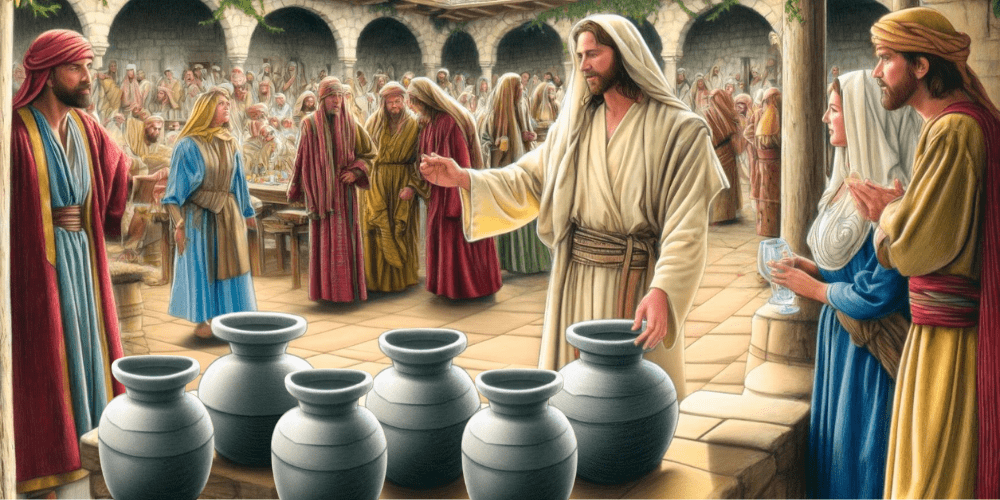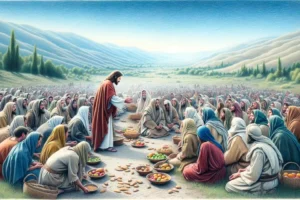
Turning Water into Wine at Cana: John 2
Here are some quick facts about the biblical story of Turning Water into Wine at Cana, as found in John 2:
- Event Location: The miracle took place in Cana of Galilee, during a wedding feast to which Jesus, His mother Mary, and His disciples were invited.
- First Miracle: This event marks the first of Jesus’ miracles in the Gospel of John, signifying the beginning of His public ministry.
- The Request: The miracle was performed after Mary, Jesus’ mother, informed Him that the wedding party had run out of wine, a significant social faux pas at the time.
- Miracle Process: Jesus instructed the servants to fill six stone water jars used for Jewish ceremonial washing with water. He then told them to draw some out and take it to the master of the banquet.
- Result: The water was miraculously turned into wine, which the master of the banquet declared to be of superior quality than the wine served earlier.
- Jars of Water: The six stone jars used in the miracle were meant for the Jewish rites of purification, symbolizing the transformation of the old covenant into the new through Jesus.
- Witnesses: The servants, Jesus’ disciples, and possibly other attendees witnessed this miracle, leading to the strengthening of the disciples’ faith in Him.
- Symbolic Significance: The transformation of water into wine is often interpreted as symbolizing the transformative power of Jesus’ teachings and the inauguration of the New Covenant.
The theological analysis of the miracle of turning water into wine at Cana, as described in John 2:1-11, offers deep insights into its significance within Christian doctrine and its implications for understanding the nature of Jesus Christ, the role of Mary, and the symbolism of the wine. Here’s a detailed exploration:
1. The Nature of Jesus’ Miracles
This miracle is the first recorded sign in the Gospel of John, which is significant because John refers to Jesus’ miracles as “signs.” These signs are meant to reveal Jesus’ divine nature and His mission. The transformation of water into wine is not just a miraculous intervention in a social event but a sign pointing to the greater reality of Jesus’ power over creation and His ability to bring about transformation.
2. Jesus’ Identity and Mission
In John’s Gospel, the signs performed by Jesus reveal His identity as the Son of God and the expected Messiah. The act of turning water into wine demonstrates Jesus’ glory and His disciples’ faith in Him (John 2:11). It serves as a metaphor for the transformative power of Jesus’ ministry, from the old covenant represented by water, used for Jewish purification rites, to the new covenant of salvation and grace, symbolized by wine.
3. The Role of Mary
Mary’s role in this miracle is noteworthy. Her statement, “They have no more wine,” and her instruction to the servants, “Do whatever he tells you,” (John 2:3-5) highlight her faith in Jesus’ ability to address the situation and her intercessory role. This has been interpreted by some as symbolizing Mary’s broader theological role as an intercessor for believers in Christ.
4. Symbolism of Wine
Wine in the Bible is often a symbol of joy, festivity, and the blessings of God. In the context of this miracle, wine can be seen as symbolizing the fullness of joy and blessing that Jesus brings through His ministry, death, and resurrection. It also prefigures the Last Supper, where Jesus uses wine to institute the Eucharist, symbolizing His blood shed for the forgiveness of sins.
5. Theological Implications of the Miracle
- Initiation of Jesus’ Public Ministry: This miracle signifies the commencement of Jesus’ public ministry and His revelation as the Messiah to His disciples.
- Foreshadowing of Jesus’ Passion: The miracle at Cana foreshadows the Last Supper and Jesus’ sacrificial death. Just as the wine at Cana was a sign of joy, the wine of the Eucharist symbolizes the ultimate sacrifice for humanity’s redemption.
- Transformation and New Creation: Theologically, the miracle signifies the transformation that Jesus brings into the lives of believers. Just as water was turned into wine, Jesus transforms believers’ lives, offering renewal and fulfillment.
6. Eschatological Dimension
The miracle also has an eschatological dimension, pointing forward to the messianic banquet at the end of times. The abundance and quality of the wine symbolize the overflowing blessings of the Kingdom of God, where there will be no lack and joy will be complete.
In summary, the miracle of turning water into wine at Cana is rich in theological significance, pointing to Jesus’ identity, His mission of transformation, and the inauguration of the New Covenant. It symbolizes the transformative power of faith in Christ and the eschatological hope of the Christian faith.



